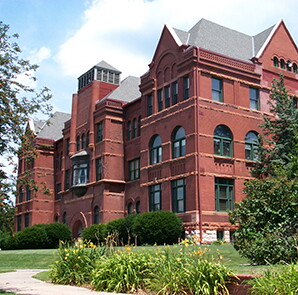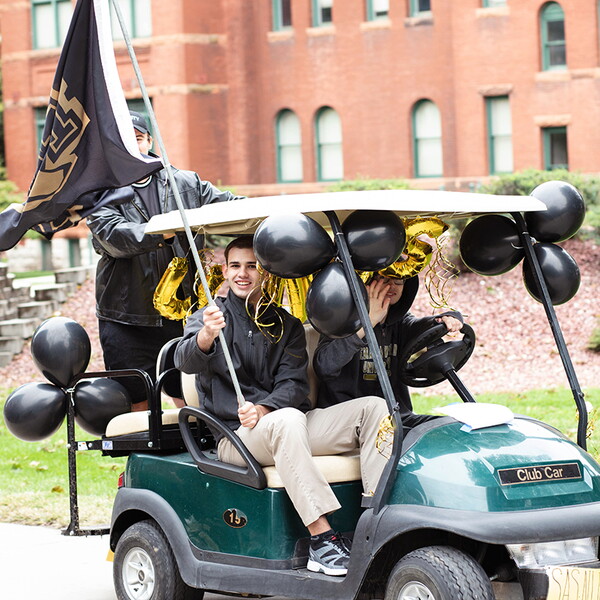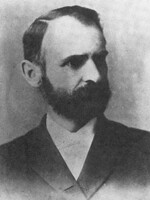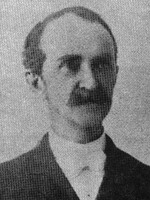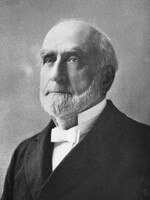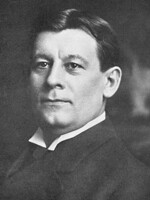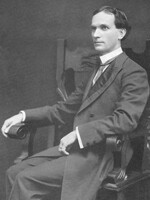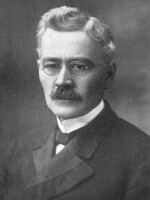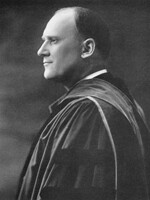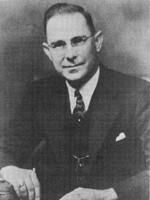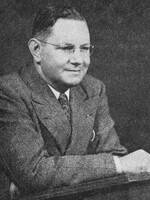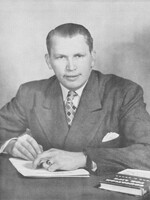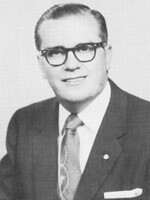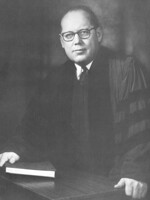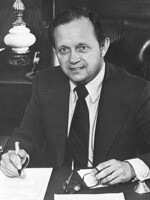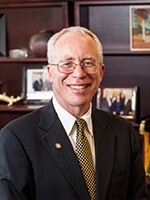|
Charles F. Creighton
1888 – 1893
- 1887 marked history with the laying of Nebraska Wesleyan University’s first building, Old Main.
- Chief architect of the proposal to locate the new university in or near Lincoln, and author of the university’s bylaws.
- Key enforcer to save Nebraska Wesleyan when it was seen to be failing miserably in March 1888. He kept it alive and going.
- In 1888, a full-year’s tuition, plus incidentals, cost $42.
- Willard Sorority was founded in 1889 and is the nation’s oldest “local sorority” of continuous existence.
- In 1890, football was cancelled because it tended to arouse “ungentlemanly” conduct in students such as anger and swearing, however, did resume in 1908.
- First four students graduated from Wesleyan – all women – in 1890; Four men graduated in 1891.
|
|
|
Isaac Crook
1893 – 1896
- Descendant of Plymouth’s William Bradford and of a grandfather who fought at Bunker Hill.
- Reorganized and restructured the university’s academic program.
- 1894 – Someone tried to set fire to Old Main and did burn down the Haish building.
- The official Wesleyan seal, which is still used today, was created in 1894.
- The colors yellow and brown are based upon the sunflower, the school’s earliest symbol; Sunflowers once filled the field where Old Main was built.
|
|
|
Dewitt Clinton Huntington
1896 – 1908
- 1900 - Foundation was laid for the First United Methodist Church at 50th Street and St. Paul Avenue.
- 1904 - The south wing for the first Music Conservatory was built, which was later named the C.C. White Memorial Building.
- 1907 - The school’s mascot was changed from the Sunflower to the Coyote.
- March 1908 - Classes were cancelled and students, faculty and friends paraded through the town and campus to celebrate the first $100,000 endowment.
|
|
|
William Joseph Davidson
1908 – 1910
- The liberal arts education was defined. Prior students graduated within divisions but now they were to graduate from the entire college with all departments included.
- Gained services of local physicians who acted as medical adviser for students at a fee to be not over more than 50 cents.
- 1909 - Proposed beginning a Booster to promote the University.
- Began the reception for students after each annual address at the beginning of each school year, which continues today.
|
|
|
Clark Adelbert Fulmer
1911 – 1917
- Alumnus of Nebraska Wesleyan and a favored son of the University.
- Students built Wesleyan’s “new gymnasium” and supplied half of the $3,200 cost.
- WJAC radio operated in the teens and twenties and was one of the first radio stations in the Midwest and possibly one of the first educational radio stations in the nation.
- 1914 - The original chapel of Old Main became the library.
- 1914 - Wesleyan received its first accreditation from the North Central Association of Colleges and Secondary Schools, which still continues to review Nebraska Wesleyan every 10 years.
|
|
|
Issac Butler Schreckengast
1917 – 1932
- He began the “I Will Maintain” Campaign to raise funds to help Wesleyan remain during the Great Depression.
- 1920 - William Jennings Bryan speaks at Nebraska Wesleyan.
- Women’s physical education classes used the attic of Old Main as a rifle range.
- 1923 - A magnificent stained glass window in Old Main was donated by a group later to be named Alpha Gamma Delta.
- 1923 - Rachel Ann Lucas Library was built, which is now the art building.
- 1927 - Alpha Gamma Delta Sorority was installed; 1928 – Phi Kappa Tau was installed.
- 1932 - Wesleyan football player Bob Gibb set a world record with a 107-yard run during a game against Oklahoma City, which was later published in “Ripley’s Believe It or Not.”
|
|
|
Elmer Guy Cutshall
1932 – 1937
- 1933 - School mascot was changed from the Coyote to the Plainsman.
- 1933 - Launched a 10-year minimum program that changed the student-faculty ratio for Wesleyan to 15:1.
- Began one of the first special scholarship endowments through the Methodist Church, one of the first scholarship funding sources available to allow more students to attend college.
|
|
|
Harry L. Upperman
1938
- Commuted between Nebraska Wesleyan and Baxter Seminary in Tennessee during his months as Chancellor.
- Only the Class of 1938 has diplomas signed by him, as he chose to stay at Baxter Seminary.
- Annual salary for the Chancellor was $4,000 plus a house.
|
|
|
Benjamin F. Schwartz
1938 – 1946
- A grade school at Wesleyan existed until the 1940s.
- 1941 - Delta Zeta Sorority was installed.
- Schwartz's mission was to vitalize religion for students.
|
|
|
John L. Knight
1946 – 1949
- During Knight’s short 2.5 year term, the student body doubled and faculty increased from 37 to 60.
- Added majors included those in art, foreign language and physical education.
- Four administrative posts were added: Director of Buildings and Grounds, Director of Religious Life; Director of Public Relations and Director of Student Relations.
- Completion and dedication of the O.N. Magee Memorial Stadium.
- 1947 - Johnson Hall was completed and open to women only, which still stands true today.
- 1949 - Theta Chi Fraternity established.
|
|
|
Carl C. Bracy
1949 – 1954
- Bracy was only 37 years old when hired as chancellor.
- During his first seven months of chancellor, he commuted back and forth from Nebraska Wesleyan and McKendree College in Lebanon, Illinois.
- During his tenure, family spirit and morale among faculty and students was at its highest in school history.
|
|
|
A. Leland Forrest
1954 – 1957
- 1957 - Set the precedent of 1200 students in enrollment.
- Expansion of the physical plant with the construction of two dormitories and a physical educational building.
|
|
|
Vance D. Rogers
1957 – 1977
- Creation of sabbatical program.
- Office of Vice President of Academic Affairs created.
- 1958 - Zeta Psi Fraternity was established.
- 1959 - John Kennedy spoke on campus.
- Tuition in 1962 was $560 per year, plus room and board.
- 9 buildings within Rogers’ tenure and $11 million in value added to campus:
- 1960 - Burt Hall and Pioneer Hall
- 1963 - Plainsman Hall
- 1965 - Fine Arts Building, which is now named the Vance D. Rogers Center Fine Arts
- 1967 - Centennial Hall
- 1969 – Olin Hall of Science
- 1970 - Cochrane-Woods Library
- 1974 - Smith-Curtis Classroom-Administration Building
- 1976 - George A. Knight Field House
- Formation of Student Affairs Division; creation of University Judiciary and Student Affairs Senate for self-government of students.
- "A Decade For Fulfillment" campaign raised $19.5 million.
|
|
|
John W. White, Jr.
1977 – 1997
- 1977 - Housing costs were raised to $630 per semester.
- 35% increase in student enrollment from 1977-1997.
- 1981 - Elder Speech and Theater building completed.
- 1992 – The University Choir was the first American choir to perform by invitation at the St. Petersburg, Russia, International Choir Festival.
- 1996 - Completion of Weary Center for Health and Fitness.
- "Campaign for Vision 2000" raised $46.5 million.
|
|
|
Jeanie Watson
1997 – 2006
- First female president of Nebraska Wesleyan.
- 2000 - Mascot changed from Plainsman to the Prairie Wolves.
- 2003 - Formation of Omaha instructional site.
- Advancing Wesleyan Honors Academy to the largest high school/college concurrent enrollment program in Nebraska.
- Academic additions include: Master of Forensic Science, Master of Science in Nursing, Master of Arts in Historical Studies, and Bachelor of Business Administration through Adult and Graduate Programs.
- 2003 - Completion of suite and townhouse style residence halls.
|
|
|
Frederik Ohles
2007 – 2019
- 2014 – Archway Curriculum introduced, cited as exemplary in U.S. higher education.
- Improvements to residential and athletic facilities.
- 2016 – NWU joined American Rivers Conference for athletics.
- MBA and M.Ed. degrees added.
- 2019 – Duane W. Acklie Hall of Science opened.
- Bold Designs campaign (2012-2019) raised $67 million.
|
|

